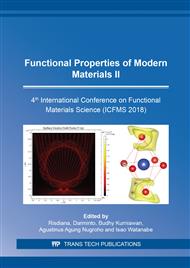[1]
Liu, H., Zhao, W., Synthesis of LiFePO4/C by Solid-liquid Reaction Milling Method. J. Powder Technol. 197 (2010) 309–313.
DOI: 10.1016/j.powtec.2009.09.019
Google Scholar
[2]
Mandi J., Yunlong X., Zhen Z., Huang Z., Dong L., Chongjun Z., Xiuzhen Q., Chunhua Z., Preparation and electrochemical performance of La3+ and F− co-doped Li4Ti5O12 anode material for lithium-ion batteries. Journal of Power Sources, 263 (2014) 296–303.
DOI: 10.1016/j.jpowsour.2014.04.051
Google Scholar
[3]
Trócoli, R., Sylvain F., Manuel C., Julián M., and Jesús S.Peña, Improving the Electrochemical Properties of Nanosized LiFePO 4-Based Electrode by Boron Doping., Electrochimica Acta 135 (2014) 558–67.
DOI: 10.1016/j.electacta.2014.04.187
Google Scholar
[4]
Zhang, Y., Huo, Q., Du, P., Wang, L., Zhang, A., Song, Y., Lv, Y., Li, G., Advances in New Cathode Material LiFePO4 for Lithium Ion Batteries,, Synthetic Metals, 162 (2012)1315–1326.
DOI: 10.1016/j.synthmet.2012.04.025
Google Scholar
[5]
Tang Y, Huang F, Bi H, Liu Z, Wan D. Highly conductive three-dimensional graphene for enhancing the rate performance of LiFePO4 cathode. J. Power Sources, 203 (2012) 130–134.
DOI: 10.1016/j.jpowsour.2011.12.011
Google Scholar
[6]
Malik R, Burch D, Bazant M, Ceder G, Particle size dependence of the ionic diffusivity. Nano Lett. 10 (2010) 4123–4127.
DOI: 10.1021/nl1023595
Google Scholar
[7]
Ding Y, Jiang Y, Xua F, Yin J, Ren H, Zhuo Q, Long Z, and Zhang P. Preparation of nano-structured LiFePO4/graphene composites by coprecipitation method. Electrochem. Commun. 12 (2010) 10–13.
DOI: 10.1016/j.elecom.2009.10.023
Google Scholar
[8]
Qin X, Wang X, Xiang H, Xie J, Li J, and Zhou Y. Mechanism for hydrothermal synthesis of LiFePO4 platelets as cathode material for lithium ion batteries. J. Phys. Chem. C.114 (2010) 16806–16812.
DOI: 10.1021/jp104466e
Google Scholar
[9]
Wang Y., Sun B., Park J., Kim W. S., Kim H. S., and Wang G., Morphology control and electrochemical properties of nanosize LiFePO4 cathode material synthesized by co-precipitation combined with in situ polymerization. J. Alloys and Compounds. 509 (2011) 1040–1044.
DOI: 10.1016/j.jallcom.2010.08.161
Google Scholar
[10]
Yang K., Deng Z., and Suo J., Synthesis and characterization of LiFePO4 and LiFePO4/C cathode material from lithium carboxylic acid and Fe3+. J. Power Sources. 201(2012) 274–279.
DOI: 10.1016/j.jpowsour.2011.11.019
Google Scholar


